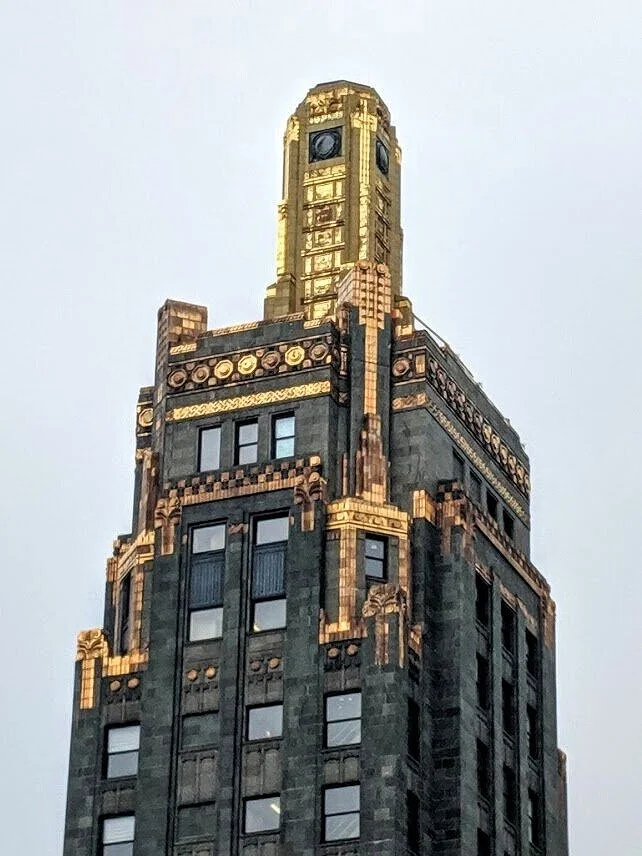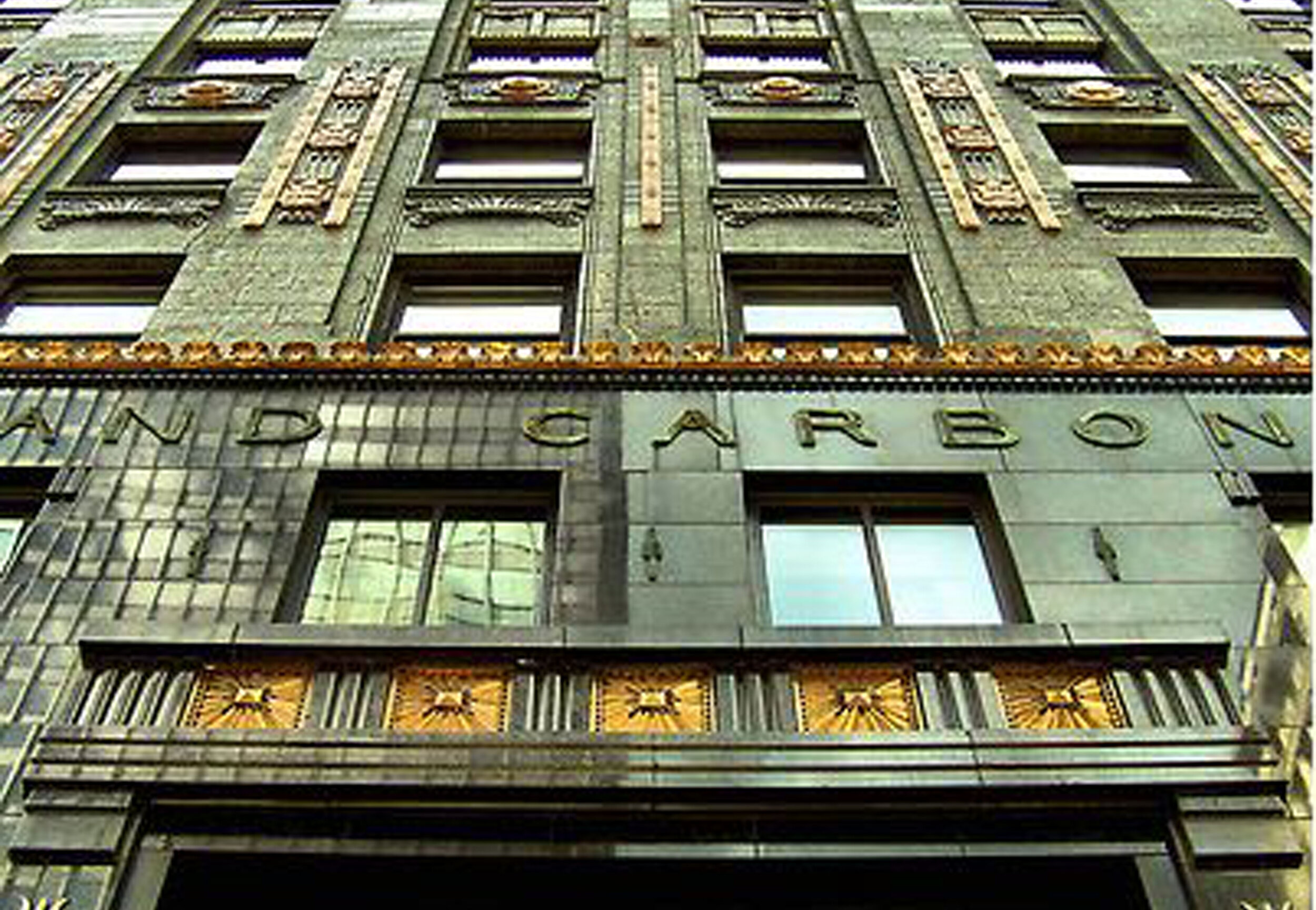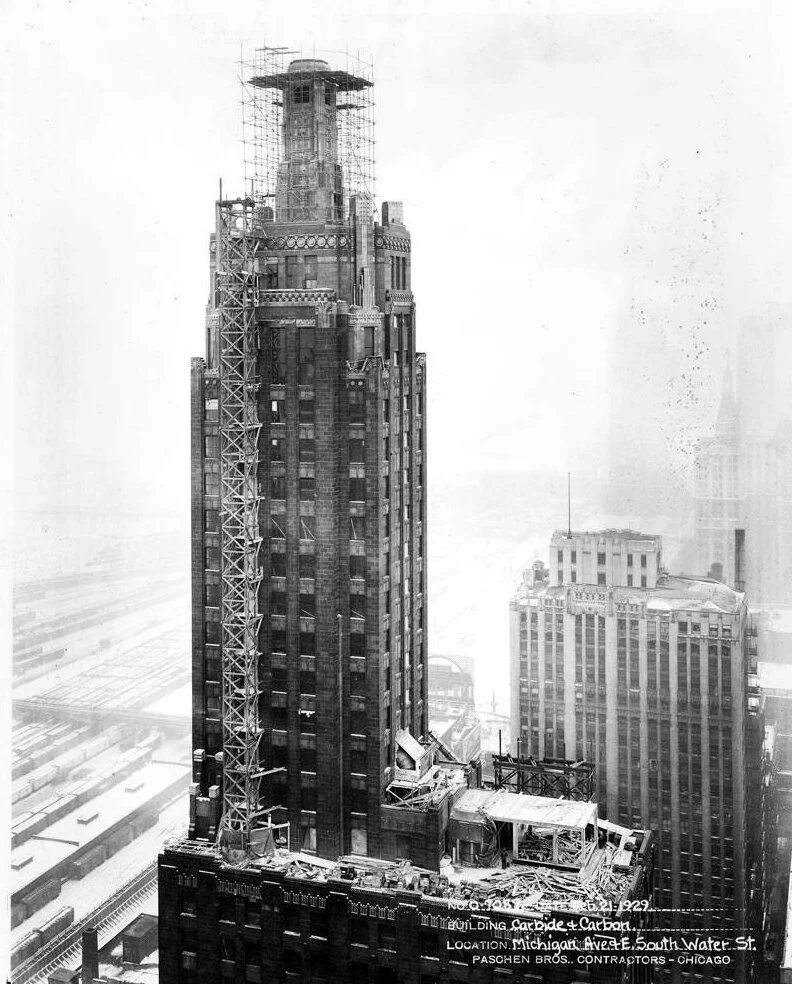Art Deco Glam: The Carbide & Carbon Building
Go inside this famous gem on our “All That Glam” Art Deco tour!
This week’s building is one of the most beautiful — and perhaps most famous — buildings in Chicago: I’m talking about that giant champagne bottle on Michigan Avenue, the Carbide & Carbon Building. Finished in 1929 and designed by sons of Daniel Burnham himself, it is impossible to miss not only because of its appearance, but also because of its location at the corner of Michigan Avenue and Wacker Place. A block south of the DuSable (Michigan Avenue) Bridge, and a couple blocks north of the most popular tourist attraction in the state of Illinois, Millennium Park, it lies directly on the path between these two hot spots, but is definitely more noticeable from afar – passers-by tend to miss it, distracted by the crowds and possibilities that await them a block in either direction. When I point it out to them at street level, I’m often met with an “Oh, that’s THIS building?!” Even better is when I bring tour guests inside the beautiful lobby on our “All That Glam” tour, and we get to see what a classic Art Deco interior looks like. What a treat!
So what’s the history of the building? The Union Carbide & Carbon Company, formed in 1917 from the merging of two companies founded in the 1880s, had a particular statement they wished to make with the design of this stunning Art Deco tower. A 1930s rental brochure lured businesses by appealing to their sense of the same architecture-society (or beauty-order) connection that Daniel Burnham had made decades before with his “White City” and the consequent City Beautiful Movement:
“The effect of such beauty in a building upon the morale of the people employed in it is unquestionably beneficial and inspiring; and to clients, business associates, and visitors, it is constant assurance that the organizations they are dealing with are of the highest calibre.”
Now, by the time they moved into this building, this company didn’t exactly need to prove its mettle to be known: scientists from the merged companies had dramatically improved upon the then-recently patented dry-cell battery, and had introduced the first D-cell battery for mass consumer use in 1896. The “Columbia dry cell,” as it was known, was a huge preliminary step in making ever-improving technologies accessible to the masses; not coincidentally, the flashlight was invented that same year. This company certainly wasn’t just full of hot air and high hopes when they claimed that their new building “possesses prestige value unequaled in Chicago.” They made safe, portable power accessible to the average consumer, and America’s love for all things electric boomed.
Photo credit: Chicagology.com
It is fitting, then, that the Carbide & Carbon Building should be rather glitzy and glamorous in its design, considering its owners and its era. Constructed during the late-1920s boom that saw our best-known Art Deco buildings built in Chicago — the Board of Trade, the Palmolive Building, the Merchandise Mart, the LaSalle-Wacker Building, 333 N. Michigan Avenue, etc. — this rather flamboyant, yet elegant, tower was one of many that eagerly populated Michigan Avenue in the years following the construction of the 1920 Michigan Avenue Bridge. (The bridge connected the formerly part-industrial, part-residential area of River North with the retail- and consumer-heavy area of the Loop, and Michigan Avenue quickly became one of the places to be for prominent business folk. The Michigan Avenue Bridge, together with the widening of the existing “Pine Street” to the north of the river, allowed Chicago to have its own version of a “Boule Mich” to add to its “Paris on the Prairie” character.) This building’s exterior features polished black granite, green and gold terra cotta, and gold leaf and marble accents, while its lobby is adorned with “Noir Belge” — Belgian Marble that is one of the most expensive marbles in the world. And as if that wasn’t luxurious enough, the highly recognizable tower at the top, once a beacon like the one atop the Palmolive Building, is clad entirely in 24k gold leaf. A building conspicuously colorful in an era of relatively demure buildings might risk being garish or ostentatious; not so with the Carbide & Carbon. Stunning and unique, yes — flashy, no. You can play a game of “Where’s Waldo” with it in the 2019 photo below…
Converted into the Hard Rock Hotel in 2004, it underwent another renovation in 2017 after the owners cut ties with Hard Rock and reopened in 2018 as the St. Jane Hotel, named in honor of Jane Addams – a name change which I personally love. Jane Addams was a community activist and social worker – indeed, she was one of the founders of social work as we know it, founding the incredibly important Hull House – and the first American woman to be awarded the Nobel Peace Prize. Though not actually a “saint” as the hotel’s brief stint under that name would suggest (if you want an American woman who was actually canonized a saint and had major ties to Chicago, check out Mother Cabrini), she was nonetheless one of the most important and influential American women to have ever walked Chicago’s streets.
Now the Pendry Hotel, it is open to the public, so whether you book a stay there or simply come in to see the lobby, do yourself a favor and take a peek at the interior. Contrary to popular belief, you don’t have to wait for some special point in the year for these doors to open – they’re open to you year-round, so go treat yourself to a true Chicago gem. Resplendent in all its polished glory, it can certainly lift even the lowest spirits on their way to work — which is, as I noted before, one of the aims of the building’s original developers. Imagine if you had worked in this building, passing through such beautiful surroundings on the way to another day at the office: wouldn’t you be filled with just a little more pride about what you do?








